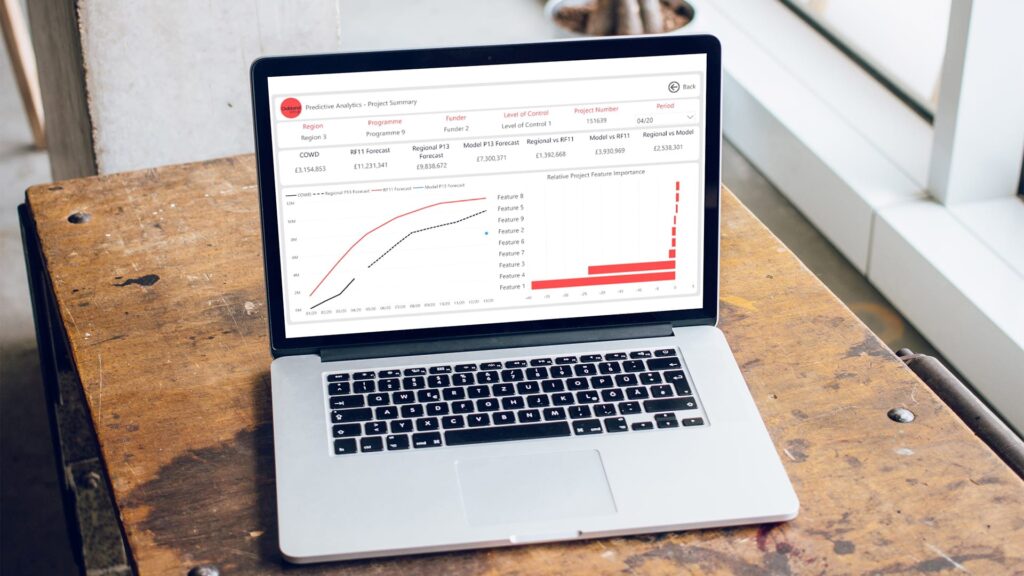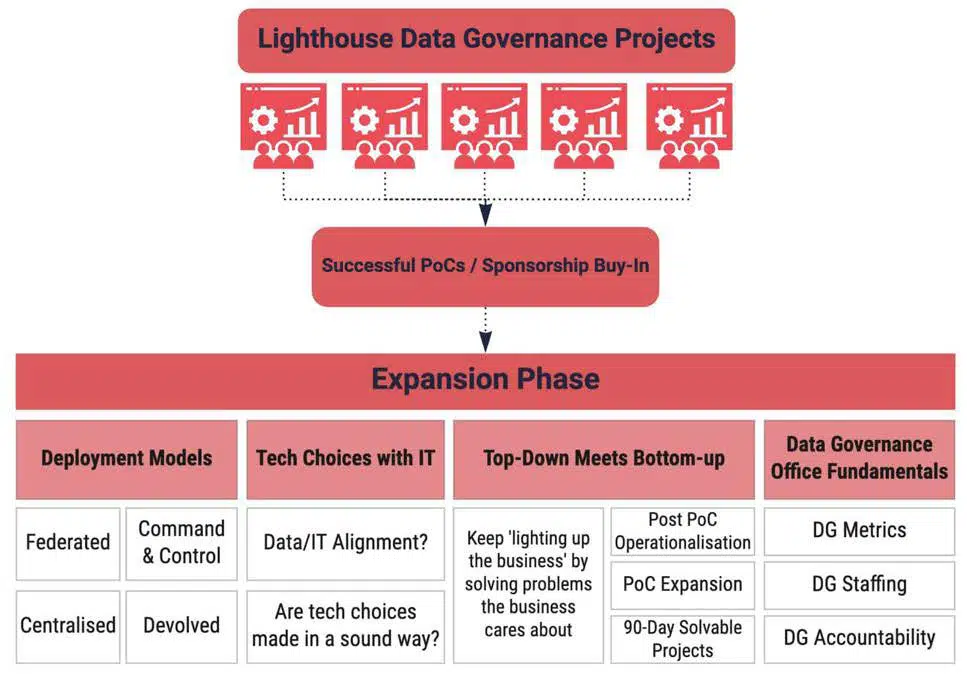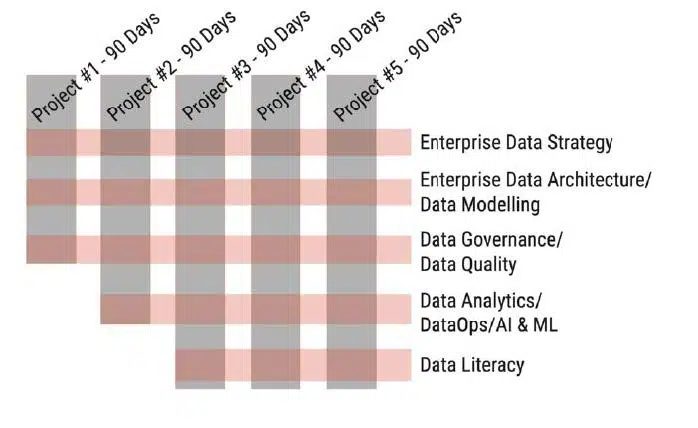Introduction
Chances are, you’re reading this guide because you’ve been asked to launch, support or accelerate some form of data governance initiative.
Congratulations – you’re embarking on a worthy endeavour.
Here at Oakland, our Data Governance team have trodden a similar path as we helped guide our clients across multiple data governance implementations. The results have been profoundly beneficial; often in ways the organisation had never considered at the outset.
Having delivered a number of large data governance programs, we’re in the fortunate position to look in the rear-view mirror and spot those critical activities that held the key to success.
We’ve curated those learnings into this guide to provide a ‘warts and all’ account of what you can expect as you embark on your own data governance journey.
Finally, as you’ve no doubt experienced, every data initiative presents its own distinct challenges. If you would like to discuss how our approach could help your organisation deliver a more successful data initiative, please book a discovery call to discuss further.

Part 1: Building the foundation for a successful data governance program
What motivates the next generation of data governance stakeholders?
At Oakland, we typically see the demand for an enterprise-wide data governance process initiated as part of a broader data foundation or enterprise-wide digital transformation. Many clients are keen to embark on their data journey in a quest for monetisation and the creation of new opportunities through innovation.
There is a growing realisation that better enterprise data leads to increased business performance, smarter decision-making and significantly reduced risk. As a result of these strategic triggers, we increasingly find executive stakeholders reaching out for guidance.
Making enterprise data management changes centrally in these organisations can be a challenge because they are often organised around different segments or geographies. There is also a lot of autonomy in large organisations, so to make changes centrally you’ve got to be business-led.
People have to see the value in the changes you want to make.
The data governance process: ‘What vs How’
If you’ve spent time sifting through the vast amount of books, articles, webinars and frameworks on the topic of data governance, you’ll soon realise that the ‘whats’ of data governance are reasonably well understood and readily available. Most organisations we speak to know what is required to get the basics of data governance in place.
However, particularly with larger, federated businesses, the translation from the ‘what’ into the ‘how’ is where many data governance programs begin to struggle.
This question of how to deliver data governance in a way that engages and motivates the business, whilst simultaneously laying a future data governance foundation, is a challenge we’ve obsessed over for many years at Oakland.
It’s through this obsession that led us to the realisation that many business cases are not positioned correctly to launch a successful platform for data governance.
Re-thinking the data governance business case
In the early beginnings of our data governance practice, we would collaborate with clients to build defensible business cases for data governance, often as a request to help construct a large data transformation program.
The data management fundamentals
Large-scale data and digital transformation programs typically incorporate a broad swathe of data fundamentals such as:
- Data Strategy
- Master Data Management
- Data Analytics (Business Intelligence, Data Warehouse, Data Lakes)
- Data Quality Management
- Metadata Management and Data Lineage Data Stewardship
- Data Protection and Regulatory Compliance
- Big Data
If you’re embarking on a similar data transformation, there are comprehensive frameworks such as DAMA DMBOKv2 that provide a comprehensive ‘what’ list of data elements required for the ‘mega-transformation’ projects.
Whilst it seems logical to combine data governance with all the other elements of a large-scale data transformation journey, you will often bump into challenges when constructing the data governance business case and getting it approved.
The four pillars of a successful data governance business case
To address the previous challenges, we discovered that a more pragmatic approach is to build a data governance business case with a simpler, four pillar approach:
Limit the early investment
Plan a modest level of investment, resisting the urge to build an ‘all-encompassing’ data governance program
Focus on value creation
Focus on value creation – deliver a series of tactical ‘Lighthouse Projects’ that create value for the business
Fly under the radar
Gradually establish your data governance program and enabling activity in ‘stealth mode’
Lock in the gains
Create the ‘foundational cornerstones’ for Data Governance as each Lighthouse Project is delivered
Launching your data governance framework with stealth: Applying the ‘Lighthouse Project’ approach
When we switched to helping clients implement data governance through ‘Lighthouse Projects’, we found that executives were more likely to get on board when they were investing in quick wins that delivered faster returns, as opposed to much larger data governance programs that often grapple for attention amongst so many other transformation programs.
Larger data governance programs often run into additional problems once they get past the business case phase, such as:

- Interest stagnation: Too much emphasis is placed on building the data governance foundation, at the expense of solving problems that are attractive to the business.
- Lack of ownership: Data cuts across organisational boundaries, so this requires new data ownership and accountability structures that are often lacking from data governance initiatives.
- Hidden data risks: It can be challenging figuring out where the risks are within your present data landscape, and which ones require attention.
- Lack of adaptation: You can’t copy and paste a data governance framework in the hope that ‘one-size-fits-all’. Instead, you need to adapt your implementation with a mix of different tactics over the long-term.
Through the delivery of high-value Lighthouse Projects, the foundations of your data governance framework can start to be deployed, but without the burden and resistance associated with a much larger program.

Setting up your data governance strategy for success
We typically aim to apply a 3-stage process when our data governance team works with clients:
- Stage 1: Set the Direction (Defining the Data Governance Strategy)
- Stage 2: Plan the Execution (Implement the Data Governance Strategy)
- Stage 3: Executing your Lighthouse Projects (Proofs of Concept)
Stage 1: Set the Direction (Defining the Data Governance Strategy)
The best approaches to data governance and the ‘exploitation’ of data must first seek to capture ‘management intent’. Once this is understood, you can then ‘smuggle’ data governance into the business using projects that engage and excite people whilst laying the necessary real-world data governance policies and supporting structures, such as data stewardship and accountability frameworks for data stakeholders.
Technical skills and tools are important but should support, not lead, your data governance strategy. For example, a data governance tool is meaningless if you don’t have committed and trained group of data stewards capable of building out a corporate data stewardship capability.
Key Dimensions of Data Governance Strategy Readiness
There are three key capability dimensions that will provide the focus for defining the data governance strategy:
Business Capabilities:
Understand current business priorities for data and test coherence through policies, governance and leadership structures.
Operational Capabilities
Sample key processes and data lifecycles to determine alignment with key data management principles. Gather evidence of operational behaviours, both positive and negative.
Data Capabilities:
Understand the data architecture and its footprint, together with any existing data management capabilities (e.g. tooling for data quality, master data management, metadata, data maturity metrics, data dictionary of data assets, data definitions completeness, data domains under governance, data owners assigned to existing data stewardship controls etc.)
Stage 2: Plan the Execution (Implement the Data Governance Strategy)
By applying some intentional planning in a multi-faceted approach, you will be able to:
- Balance the various leadership (and political) drivers, whilst establishing clear ownership of the key levers of change (e.g. financial approvals)
- Manage the narrative, particularly around the tendency for inflated expectations that are so often associated with large data initiatives Curate and support your portfolio of ‘Lighthouse Projects’ (POCs) on two-fronts:
- Business outcome success stories that everyone can get excited about
- Targeted interventions to address areas of poor practice/high risk (e.g. regulatory compliance and data protection weaknesses)
- Drive the necessary data governance policy, standards, frameworks and overall data governance process, that support the strategic direction of travel
Inputs to Stage 2
To prepare your Stage 2 planning activity, you will typically require various supporting documentation and insights such as:
Existing data strategy and data foundation plans
The known ‘whats’ of a preferred data governance process/strategy Previous data maturity assessments, baseline reviews and data audits Any other supporting documentation

Preparing the Data Governance Strategy Plan
During this phase, we would typically expect to carry out the following activities:
- In-depth interviews: Exploring possible root-causes of issues and areas of opportunity
- Landscape review: Investigate known data-related initiatives to identify focus areas and avenues for collaboration/harmonisation
- Deep dives and sampling: Reviewing the key data lifecycles and data management processes to identify good/poor practices as a reference point Data management maturity review: Provide a baseline data maturity assessment through quantitative and qualitative metrics, covering all aspects of people, process, systems, technology and data governance
- Central capability review: You will need to review the available capacity and capability of your central data function against their ability to deliver on your vision for data.
Following this initial preparation work, you will have some clear indication of where the major gaps, opportunities and readiness exists within your current data landscape.
Creating the ‘Commissioning Document’
At Oakland, we recommend creating a ‘commissioning document’ that aligns senior management and various stakeholders around a set of common goals and plan to move forward.
This document is likely to include:
- Components of the overall data governance strategy with an order and intensity in which they should be progressed
- Assessment of the central support required (e.g. additional comms, policy development, standards)
- Identification of any technical needs, beyond the POCs (e.g. Master Data Management (MDM), Data Quality, Metadata and Data Dictionary for Data Definitions and Data Lineage etc.)
- Key delivery risks and issues
The plan needs to be resilient enough to cope with any organisational or leadership changes, and coordinated in a way that is most likely to succeed in the medium-term.
Typically, a core team will continue to support delivery of the plan as it rolls on into future phases.
Stage 3: Executing your Lighthouse Projects (Proofs of Concept)
For this stage, we’re going to focus on the process of launching ‘Lighthouse Projects’ because we find that when executed correctly, they form the driving force for an effective data governance strategy.
Lighthouse Projects Proof of Concepts (POCs) form a crucial component of your overall data governance strategy as they engage the business in tactical improvements that capture attention. These improvements create success stories that build momentum, reduce risk and establish confidence in your approach.
Overcoming resistance to data management change
Many organisations suffer from ‘change fatigue’.
When starting out, you’re going to be ‘smuggling’ data governance into the organisation so make sure your project’s mission is 100% focused on the ‘pains and gains’ that those in the business already recognise.
The first rule of Data Governance – don’t talk about Data Governance
You don’t always want to label your first Lighthouse Project as a ‘Data Governance Initiative’ because you’ll often face enough resistance as it is, without introducing a phrase that many have never heard before!
For example, with one client, we selected a project that addressed an asset data quality headache that had been frustrating the business for some time.
We could have adopted a top-down approach and waited to build out accountability structures for data governance, create data quality assessment frameworks, train the business in data literacy and select a team of data stewards to manage the information chain.
Instead, we addressed the root-cause of why the data asset system was creating poor data quality.
We then introduced a system for onboarding data stewards, discovering metadata, defining data quality metrics and controls – all the elements of a data governance capability, but in a much shorter timeframe than if we had waited for a full data governance program to be rolled out
Which data management improvements should you consider for a Lighthouse Project?
When considering the monetisation opportunities of your Lighthouse Projects, we recommend ‘two waves of attack’.

Wave 1: Initial assessment against an agreed project selection criterion
This phase should identify a prioritised list of candidate POCs drawing on the selection criteria previously discussed. For example, you may collapse a list of candidate projects from 20 down to 5 possible options.
Sample criteria and considerations for Lighthouse Project selection
Every organisation has scope for data improvement, so your initial challenge will be determining which Lighthouse Projects should be candidates for consideration.
Having delivered many of these projects, we’ve found the following advice to be a good starting point for selecting the best data management/business improvement projects to kick off your strategy of ‘data governance by stealth’:
- Identify which projects are most likely to succeed – reduce the scope rather than fail an overly ambitious target
- Clearly define the scope – understand the specifics of the business problem being solved and its technical / data viability
- Focus on business-led projects – look for projects that rely on active contribution from the business
- Look for balance across the POCs – shortlist a ‘project portfolio’ that will nurture good ideas and opportunities, whilst tackling areas of poor data practice
- Consider what happens at the end of the POC – is the purpose to prove viability (and perhaps discard afterwards) or build a fully supported solution?
Wave 2: Investigation of each candidate POC
In this phase, you will start by validating project feasibility and scope, before arriving at an attractive set of options for more detailed investigation that will be completed at the end of Wave 2.
Investigation focus areas
Each investigation will typically focus on areas such as:
- Use case definition
- Business processes Technology
- Data availability
- Data quality and associated metrics
- Risks and challenges for delivery
- Delivery planning
Upon completion, Wave 2 will select a focused set of projects that fully address several frustrating business problems. These projects will allow you to introduce key elements of your data governance roadmap as a side-benefit, but without the fanfare and resistance so often associated with a major data governance program.
Depending on the scale of each candidate project, it typically requires 10-20 days to complete the POC investigation.
What team will you need for POC investigation?
Within our data strategy and governance consulting practice, we typically deploy a core investigation team consisting of:
- Business translator (SME)
- Business analyst
- Technical data architect
The exact make-up of the investigation team needs to adapt to the specifics of your data, process, and technology landscape.
For example, some projects may be deeply technical in nature, requiring expertise in data interface accessibility, workflow automation and Big Data platforms.
Other times, the project requires ‘softer’ skills in the form of data literacy at the grassroots level, educating a team of stakeholders to take accountability for decision-making, or simply coordinating a team of data stewards to set more robust data definitions and assessment metrics for their data assets.
The key is to work with a data governance team who have the experience to address the complex and varied types of data challenges that typify the modern enterprise.



Part 2: Aligning the data governance and data strategy roadmap
One challenge you’re likely to face is the issue of alignment of a data strategy to transition your first Lighthouse projects into a full-blown data governance capability. It’s not enough to deliver lots of successful Lighthouse projects, they still need to fit within a coordinated ‘master plan’.
The following diagram highlights some of the essential considerations when expanding Lighthouse projects into a broader data strategy and governance framework:

This approach relies on 3 vital building blocks that are essential to the longer term progress of your data strategy and governance roadmap:
- Creating a business-led authority
- Establishing your ‘Controlling Mind’ for data
- Launching ‘Data Management-Enabling’ projects
Building Block #1: Creating a business-led authority
In this phase, you will be establishing the subordinate organisation required to manage the accountabilities for delivering the anticipated outcomes of your data governance initiative.
Key activities are setting up the coordination, assurance and ownership of data domains within each directorate across the organisation.
In particular, you’ll need to train the business on what it means to be the accountable owner/steward of a data domain, particularly with data domains that span multiple departments and functions within the company.
Building Block #2: Establishing your ‘Controlling Mind’ for data
As you deliver more Lighthouse Projects, you’ll develop the need for a ‘Controlling Mind’ to help coordinate and operationalise your ongoing data- related activities so that your data is treated as an asset.
For example, in order to retain the necessary skills, you’ll be looking to transition the required data capabilities as each Lighthouse Project is completed.
There are three specific requirements for building a ‘Controlling Mind’ and the required supporting capability:
- Setting the Direction: Defining a data/governance strategy and ensuring alignment with relevant strategic initiatives.
- Controlling/Assuring Data Assets: Managing the availability and quality of your data, including its integrity and security. Included in this step is the development of your core data governance processes, including relevant metrics and measurement of key behaviours.
- Building the Capability: Depending on the preferred deployment model, you will develop a Centre of Excellence (CoE), offering the necessary training and support foundations.
Note:
A Data Governance Centre of Excellence (CoE) should drive the development of data expert communities and stewardship forums, made up of business and technical teams.
The CoE would provide provisioning recommendations for data tooling and a constant monitoring to ensure data maturity is progressing in the right direction.
The Oakland Group has extensive experience in creating Data Governance, and Data Management, Centres of Excellence.
Please get in touch with us for more details.
Get in touchBuilding Block #3: Launching ‘Data Management-Enabling’ Projects
As each Lighthouse Project gets completed, you’ll find yourself iteratively building deeper foundations of data management capability, albeit fully aligned to business outcomes.
By taking the outcome-driven approach, you can advance data maturity and data capability one project at a time, but in alignment with any goals for your other areas of focus such as:
- Data Capability Target Operating Model (ToM)
- Data Architecture
- Technology Strategy
- Enterprise Data Strategy
Success depends on getting the business engaged and excited about the art of the possible as each ‘slice’ of data capability increases in maturity following each project win.
When the business experiences the positive change resulting from data, they start to drive and take ownership of the ‘data conversation’, which is preferable to relying on IT and technical teams to guide the way.
We’ve found this Agile approach delivers far more impact against strategic and tactical drivers whilst incrementally building out the key elements of a progressive Chief Data Office (CDO) function.
The diagram below illustrates how, with a recent client, we iteratively rolled out layers of data maturity and function, by executing one ‘enabling project’ at a time:

The key to this approach is to assure the completion of the most critical projects, i.e. those with executive attention.



Part 3: Tackling some common challenges
How do we overcome a perception that data governance means more paperwork and slower projects?
One of the biggest challenges faced with data governance is the negative association people have with ‘governance’ in general.
Many people assume that governance slows projects and initiatives down, ‘gumming up the works’ with bureaucracy and unnecessary controls, stifling creativity with endless approvals and administrative paperwork.
The reality couldn’t be any more different in fact.
Let’s take an example of managing data lineage across critical data assets, a common data governance activity.
Demanding that all projects have their data lineage documented prior to release, may feel like a tedious, unnecessary task. And you’d be right.
Fully documented data lineage is an end-goal for data governance, but we don’t start with a mandated policy at the beginning, that would be seen as draconian, and as a result no-one would follow it.
Instead, we adopt data lineage on a needs basis. When carrying out a Lighthouse Project, we begin to document the data lineage as we go, thus ensuring that the next project which needs our data has a 100% complete and accurate of where our data was sourced from and which parts of the business it now services.
With each Lighthouse Project completed, another piece of the data lineage puzzle is completed.
If resource is scarce, you can even prioritise the most critical data assets and ignore the rest (for now). The key here is to get started and demonstrate the benefits.
Having a reference source of data lineage provides huge value to the business:
- Data migrations and system consolidations take far less time
- Regulatory audits quickly find the data they need
- Customer data becomes accessible for subject access requests
- Management information become more trusted
- Defects are more easily identified and resolved
There are hundreds of benefits that accrue from robust data lineage, but you have to start gradually, winning support with each Lighthouse Project that you deliver.
Finally, remember that the role of data governance is not to deploy ‘the data police’ and inhibit projects. The goal should be to accelerate projects, improve their outcomes and reduce their costs. To achieve this, look at where your organisation currently struggles with its projects and identify which Data Governance elements could be deployed to turn things around.
When you do this, you’ll find it much easier to get buy-in for future data governance support.
How do we find the right data owners and stakeholders to support our data governance initiative?
Firstly, you need look at the lifecycle of your most important data.
Where is your data created? What systems and applications does the data originate from?
Think about who is responsible for the data management processes.
The starting point for your data will give you clues as to which teams and departments need to be considered for data ownership. From there, simply scale the management tree until you find a suitable candidate.
And don’t forget the business stakeholders, because ultimately data governance should be driving positive business outcomes.
Assigning data owners is critical. If you don’t have an owner for your data it’s very difficult to reach agreement on what needs to get done, and who should do it.
How do we determine the most critical data elements to include in a data governance program?
‘Where do we start’ is a common challenge we hear from our customers. There are typically thousands of data elements that are critical to any organisation, so boiling them down to the critical few can be a challenge.
As you’ve learned in this guide, at Oakland, our preference is to embark on Lighthouse Projects. These are small, benefits-focused, Proofs of Concept initiatives that tackle a specific problem. As we’re solving the problem, we begin to build the foundations of data governance.
These Lighthouse Projects drive the scope around what Critical Data Elements need to be included, but we often look for other signals and indicators that a data element is critical to the organisation.
For example, some of our clients have a master issues log. This is a register of all the most serious data issues within the organisation and the underlying data sets that are contributing to the problem.
Examining regulatory requirements can also surface the most important data elements for your data governance initiative.
Other examples can include key data that feeds into senior management reports or other important decision-making resources. For example, some organisations build complex financial models that rely on underlyling data, so it makes sense to include this foundational data in scope for data governance and data quality assurance.
Final words (and next steps)

Building out a data governance program for the first time is challenging.
Our recommendation is to first gain an overview of the ‘whats’ of data governance and then seek an experienced implementation partner who can guide you through the process of delivering smaller, business-driven, ‘Lighthouse Projects’ that deliver incremental data governance milestones.
Don’t be taken in by the industry trend of building out all- encompassing data governance frameworks until you’ve at least demonstrated repeated value from lightweight data improvement projects that help you ‘smuggle’ in the fundamentals of data governance.
You’ll find that when you come to expand your reach with data governance, you already have a captive executive audience who are primed and eager to support your continued success.
Talk to the Oakland Team
If you want to discuss any of the ideas presented, and how they would benefit your data initiative, please contact us to arrange a call.
Get in touch
